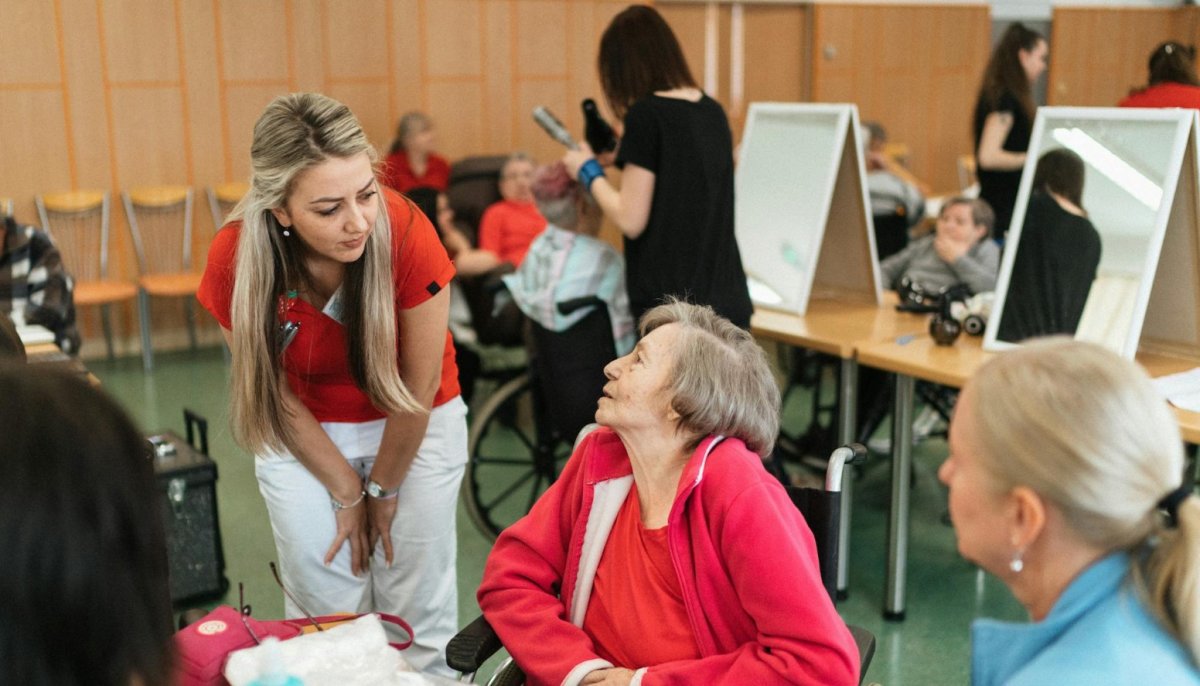
There's a great quote by anthropologist Margaret Mead: "Always remember that you are absolutely unique. Just like everyone else." It was Mead's much classier version of "Different strokes for different folks." No matter how you say it, though, it's true. Everyone has a slightly different idea of their ideal relocation spot for retirement.
For example, many couples choose retirement care communities with graduated levels of care.
While one spouse may feel reluctant to leave a longtime home and garden, the other may thrive on the new opportunities for socializing and activities. These communities can provide both security and a vibrant lifestyle, depending on individual preferences.
On the other hand, some retirees report feeling restricted by community rules.
Some retirees have found that regulations around overnight visits from grandchildren can feel too limiting and lead to disappointment with community living.
Experiences like this highlight how important it is to match personal priorities with the policies of a retirement community before making a decision.
What is a retirement community?
A retirement community offers age-restricted residential housing for older adults, typically 55-plus. Amenities and services offered vary depending on the community.
Most provide a maintenance-free environment, and include services like lawn care. Others add housekeeping, dining, and planned activities to connect residents socially.
Whether a retirement community is right for you depends a lot on your expectations.
For example, if you're a bit of a homebody, you may be interested in a community that provides tons of fun activities.
If you're using AI to find the best deals and travel the world, you may be looking for a landing pad, a place where you can hang out when you're home.
Recent data shows that over 30,000 senior living communities operate across the United States, serving approximately 1 million older Americans.
The industry has evolved significantly post-pandemic, with communities implementing enhanced health protocols and technology to keep residents connected with loved ones.
Types of retirement communities
It's easy to imagine all retirement communities as large and lively as the one featured in the 1985 movie Cocoon, but these communities come in all shapes and sizes.
Understanding your options is crucial for making the right choice:
Five Main Types of Retirement Communities
- Senior living apartments: Independent, age-restricted residences for downsizing
- Independent living: Apartments with community amenities and social activities
- Assisted living: Support with daily tasks while maintaining independence
- Skilled nursing care: 24/7 hands-on medical and daily living assistance
- Memory care: Specialized care for Alzheimer's and dementia residents
Also read: Getting ready for retirement: Tips to handle this major life shift
There is also the Continuing Care Retirement Community (CCRC), which offers graduated levels of care.
Residents may begin living independently, then transition to assisted living as they require more support.
If additional needs arise, they can move into skilled nursing care while remaining within the same community.
Many residents value knowing they will not need to leave their community to receive higher levels of care.
This peace of mind is particularly meaningful—research shows that majority of CCRC residents report high satisfaction with their ability to age in place within the same community.
The benefits of retirement community living
Retirement communities have evolved to offer much more than basic housing.
Today's communities focus on creating vibrant, engaging environments that support healthy aging. Here are the key advantages:
Enhanced socialization opportunities
If you're a social person, it's easy to stay engaged when surrounded by so many people who share many of your generational memories and are happy to invite you to join them in a game of gin or euchre.
Socialization is a huge part of healthy aging
and readily available in retirement communities.
"Social isolation can be as damaging to health as smoking 15 cigarettes a day."
Studies show that seniors living in retirement communities often enjoy more frequent social engagement than those living alone.
This increased socialization correlates with better cognitive function, lower rates of depression, and even increased longevity.

Also read: The hidden retirement crisis leaving thousands of seniors without a home
Activities and amenities
Some retirees prefer a lifestyle with activities and amenities located just steps from their front door.
Options may include swimming pools, fitness centers, or hobby clubs such as genealogy groups that encourage shared interests.
For active older adults, this type of setup provides convenient opportunities to stay engaged physically and socially.
Modern retirement communities have expanded their offerings significantly. Many now include:
- State-of-the-art fitness centers with senior-specific equipment
- Educational programs and lifelong learning opportunities
- Art studios and creative workshops
- Technology centers with computer classes
- On-site healthcare services and wellness programs
- Restaurant-style dining with multiple menu options
- Transportation services for shopping and appointments
Safety and security
One often overlooked benefit is the enhanced safety features built into retirement communities.
These include 24-hour emergency response systems, grab bars in bathrooms, wider doorways for mobility aids, and staff trained in emergency procedures.
For many families, this safety net provides invaluable peace of mind.
Also read: Make your retirement money last—15 genius, practical ways to cut costs and enjoy life more
The challenges to consider
While retirement communities can be the right choice for some, they're not right for everyone. Understanding the potential drawbacks is essential for making an informed decision.
Financial considerations
As mentioned, the cost of living in a retirement community varies wildly, based on where you live, services provided, and amenities.
Here are the 2025 national averages:
Average Monthly Retirement Community Costs (2025)
Independent living in 2025 is about $3,145/month (as reported by A Place for Mom).
Assisted living in 2025 is approximately $6,129/month (SeniorLiving.org)
CCRC entrance fees tend to center around $300,000, though they can range from tens of thousands to over half a million depending on location, amenities, and contract type.
Industry surveys show that senior living costs continue to rise, reflecting broader economic pressures and the demand for expanded services.
However, costs can vary dramatically by location.
Did you know?
Did you know?
Some retirement communities offer rental options instead of buy-in fees, making them more accessible. Additionally, certain long-term care insurance policies may cover portions of assisted living or memory care costs.
Loss of familiar surroundings
Many retirees enter community living after years of maintaining personal hobbies and outdoor spaces, such as gardening.
In some retirement communities, strict regulations or limited space can reduce opportunities to pursue these activities fully.
This adjustment can feel like a trade-off, where residents gain safety and services but lose elements of personal independence.
This loss of personal hobbies and familiar spaces affects many residents.
Studies show that many new residents report feelings of loss or nostalgia for aspects of their former homes after moving into retirement communities.
Limited age diversity
Research highlights the benefits of maintaining friendships across different age groups, which can support cognitive health and emotional well-being.
These connections often provide stimulation, fresh perspectives, and joy in everyday life.
While retirement communities offer excellent opportunities for socialization, they may limit exposure to people from other age groups.
Some communities are addressing this by creating intergenerational programs, partnering with local schools for reading initiatives, or hosting community events that welcome all ages.
Rules and regulations
Most retirement communities have strict limits on the number of nights visitors can stay, and these rules may be harder on some residents than others.
Common restrictions include:
- Visitor overnight stay limits (typically 7-14 nights per year)
- Pet size and breed restrictions
- Modification limitations to living spaces
- Quiet hours and noise restrictions
- Parking limitations for residents and guests
Also read: Five free or low-cost retirement perks you may be overlooking
Making the right decision for you
Choosing whether to move to a retirement community is deeply personal.
Here's a framework to help you evaluate your options:
Example Scenario
- Sarah, 72, loves hosting her five grandchildren for week-long summer visits. A retirement community with strict visitor policies would likely not suit her lifestyle.
- Robert, 68, recently widowed, finds maintaining his large home overwhelming and craves social connection. A retirement community's built-in social network could be ideal.
Questions to ask yourself
Before making any decisions, consider these essential questions:
- What aspects of your current living situation do you value most?
- How important is socialization versus privacy to you?
- Can you afford the ongoing costs without financial strain?
- Do you have health conditions that might require care in the future?
- How often do family and friends visit, and for how long?
- What hobbies or activities are non-negotiable for your happiness?
Financial planning strategies
If you're considering a retirement community, proper financial planning is crucial. Here are strategies to ensure you're prepared:
Financial Planning Checklist
- Calculate your total monthly income including Social Security, pensions, and investments
- Factor in annual cost increases of 3-5% for retirement communities
- Consider selling your home to fund entrance fees or monthly costs
- Explore long-term care insurance options before you need them
- Consult with a financial advisor specializing in retirement planning
Medicaid may cover some assisted living costs in certain states, but eligibility requirements are strict.
Additionally, some communities offer financial assistance programs for residents who outlive their resources.
Also read: 5 passive income ideas that can help boost your finances in retirement
Alternatives to consider
Retirement communities aren't the only option for aging well.
Consider these alternatives:
- Aging in place with home modifications and in-home care services
- Senior co-ops where residents own shares and participate in governance
- Multigenerational living with family members
- 55+ active adult communities without care services
- Village movement where neighbors support each other to age in place
How to evaluate retirement communities
If you decide to explore retirement communities, here's how to evaluate your options effectively:
Essential Steps for Evaluating Communities
Visit multiple times, including evenings and weekends
Eat meals in the dining room to assess food quality
Talk to current residents about their experiences
Review the contract with an elder law attorney
Check state inspection reports and ratings
Understand exactly what's included in fees
The technology factor
Modern retirement communities increasingly incorporate technology to enhance residents' lives. Look for communities offering:
- High-speed internet and Wi-Fi throughout the facility
- Telehealth capabilities for virtual doctor visits
- Emergency response systems with fall detection
- Apps for ordering meals or scheduling activities
- Virtual reality programs for cognitive stimulation
Making peace with your decision
Whether you choose a retirement community or another path, remember that no decision is irreversible. Many communities offer trial stays or respite care options, allowing you to experience the lifestyle before committing.
"The best time to plan for retirement living is before you need it. Having choices gives you control over your future."
What This Means For You
Like all significant decisions in life, choosing where and how to live in retirement requires careful consideration of individual needs, preferences, and circumstances.
Determining whether a retirement community offers the right blend of support, socialization, and security depends on each person’s situation.
It is important to thoroughly research available options, visit multiple communities, and engage in open conversations with family members when making a decision.
Ensuring that finances are in order and establishing a sustainable withdrawal strategy are also essential steps in preparing for potential costs.
Remember Margaret Mead's wisdom—you are absolutely unique, just like everyone else. Your perfect retirement living situation is out there; it just takes some thoughtful exploration to find it.
What factors are most important to you when considering retirement living options? Share your thoughts and experiences with our community in the comments below.
Read next:
- What’s holding you back from enjoying your retirement savings? 9 common obstacles—and how to move past them
- Unlock hidden benefits! Discover the retirement perks your bank doesn’t advertise
- Thinking of working in retirement? Here’s where seniors are thriving






